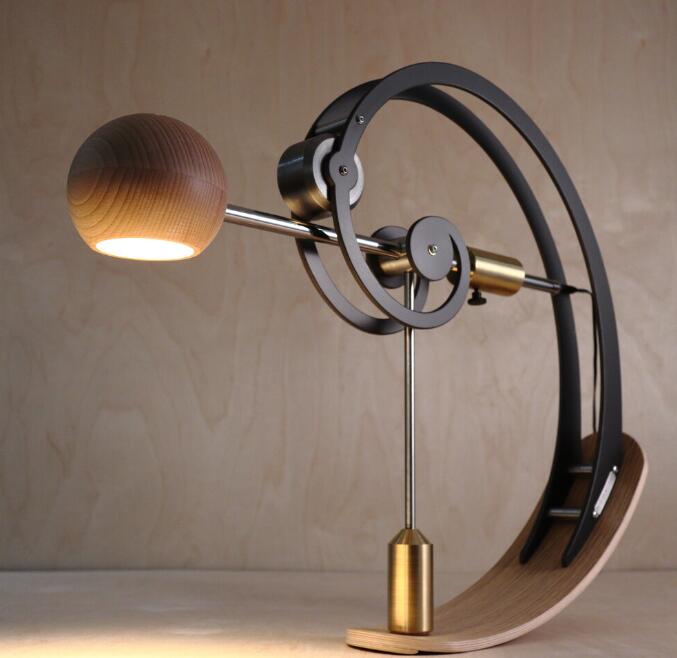Math-themed lamps have gained popularity as unique home decor items, appealing to both math enthusiasts and those with an affinity for intellectual aesthetics. These lamps beautifully integrate mathematical concepts and theorems with design elements, creating visually captivating pieces that illuminate spaces both literally and figuratively.
In this article, we delve into the world of math-themed lamps, exploring the intersection of mathematics and design. We will highlight a selection of popular math concepts and theorems that are frequently featured on these lamps, shedding light on the beauty and elegance of mathematics in unexpected places.
Pythagorean Theorem Lamp
The Pythagorean theorem is undoubtedly one of the most well-known theorems in mathematics, attributed to the ancient Greek mathematician Pythagoras. This theorem states that in a right-angled triangle, the square of the length of the hypotenuse (the side opposite the right angle) is equal to the sum of the squares of the other two sides.
Pythagorean theorem lamps capture the essence of this famous theorem through their designs. Typically, these lamps feature a geometric representation of a right-angled triangle, incorporating the theorem’s formula: a^2 + b^2 = c^2. The sides of the triangle are often represented by various shapes or symbols, emphasizing the theorem’s fundamental relationship between the lengths of the sides.
With their sleek and modern designs, Pythagorean theorem lamps not only serve as a source of illumination but also as a visual reminder of the elegance and universality of mathematical principles.
Example:
A Pythagorean theorem lamp could have a minimalist design with a triangular base, showcasing the theorem’s formula elegantly engraved on one side. The lampshade might feature geometric patterns or incorporate additional mathematical symbols to further emphasize the significance of the theorem.
Fibonacci Sequence Lamp
The Fibonacci sequence is a famous sequence of numbers in mathematics, named after the Italian mathematician Leonardo of Pisa, better known as Fibonacci. It starts with 0 and 1, with each subsequent number being the sum of the two preceding numbers (0, 1, 1, 2, 3, 5, 8, 13, and so on).
Lamps inspired by the Fibonacci sequence often showcase a visually appealing spiral pattern, known as the Fibonacci spiral or the golden spiral. This spiral, derived from the sequence, is found abundantly in nature, from the arrangement of sunflower seeds to the formation of nautilus shells.
The design of a Fibonacci sequence lamp typically incorporates the spiral pattern either in the lampshade or the lamp’s base. The intricacy of the spiral, progressively growing in scale, represents the harmonious and proportionate progression of numbers in the Fibonacci sequence.
Example:
A Fibonacci sequence lamp could have a cylindrical lampshade with an elegant golden spiral wrapping around it. The base of the lamp might feature a series of numbers from the Fibonacci sequence, highlighting the connection between the mathematical concept and the lamp’s design.
Fractal Geometry Lamp
Fractal geometry explores mathematical patterns that exhibit self-similarity, meaning they look similar regardless of the magnification level. Fractals are infinitely complex and captivating, reflecting a fascinating combination of order and chaos.
Lamps inspired by fractal geometry often incorporate designs based on famous fractal sets, such as the Mandelbrot set or the Sierpinski triangle. These designs showcase intricate, repeating patterns that draw viewers into a mesmerizing world of infinite detail.
A fractal geometry lamp might feature a lampshade adorned with a visually striking Mandelbrot set, with its complex and self-repeating patterns. Alternatively, it could showcase the Sierpinski triangle, a fractal pattern formed by recursively removing triangles from a larger triangle. The intricate and infinite nature of fractals makes them perfect for creating visually captivating and intellectually stimulating lamp designs.
Example:
A fractal geometry lamp could feature a lampshade that displays a zoomed-in portion of the Mandelbrot set, showcasing the intricate patterns and formations within. The lamp’s base could also incorporate smaller fractal shapes, demonstrating the self-similarity property of fractals.
Golden Ratio Lamp
The golden ratio, also known as the divine proportion or phi (φ), is a mathematical concept that has fascinated artists, architects, and mathematicians for centuries. It is an irrational number approximately equal to 1.6180339887.
Lamps featuring the golden ratio embrace the concept’s aesthetic appeal, as it is believed to create proportions that are pleasing to the human eye. These lamps often incorporate designs and shapes that adhere to the golden ratio, evoking a sense of harmony and balance.
A golden ratio lamp might have a lampshade with dimensions representing the golden ratio, such as a height-to-width ratio of approximately 1.618. The base of the lamp could follow the Fibonacci spiral, which is closely related to the golden ratio. The lamp’s design reinforces the concept’s presence in art, architecture, and nature, reminding us of the intrinsic value of mathematical harmony.
Example:
Imagine a golden ratio lamp with a tall and slender lampshade, carefully crafted to achieve the golden ratio dimensions. The lamp’s base could be inspired by the nautilus shell, a natural example of logarithmic spirals that conform to the golden ratio.
Euler’s Identity Lamp
Euler’s identity, often referred to as the “most beautiful equation” or “Euler’s equation,” is a fundamental mathematical formula that elegantly connects five essential mathematical constants: 0, 1, π (pi), e (Euler’s number), and i (the imaginary unit).
Lamps featuring Euler’s identity offer a visual representation of the equation, capturing the essence of its mathematical elegance. The lamp’s design combines these five constants in a harmonious yet precise arrangement, creating a captivating and intellectually stimulating visual display.
An Euler’s identity lamp might have a lampshade adorned with the equation itself, featuring symbols and numbers arranged in an aesthetically pleasing manner. The lamp’s base could incorporate geometric shapes representing the various constants, symbolizing the interconnectedness and beauty of mathematics.
Example:
Imagine an Euler’s identity lamp with a lampshade covered in a delicate script, intricately inscribing the equation using mathematical symbols and constants. The lamp’s base could feature a sculptural representation of the five constants, highlighting their significance and contribution to the equation.
Chaos Theory Lamp
Chaos theory explores the behavior of complex systems that are highly sensitive to initial conditions, resulting in unpredictable yet deterministic outcomes. Despite their apparent randomness, chaotic systems exhibit underlying order and patterns.
Lamps inspired by chaos theory elegantly capture the complex and unpredictable nature of chaotic systems through dynamic designs. These lamps often feature patterns derived from chaotic attractors or fractals, displaying intricate and visually captivating formations that draw viewers into the fascinating world of chaos.
A chaos theory lamp might have a lampshade adorned with a dynamic pattern based on a chaotic attractor, such as the Lorenz attractor or the Rössler attractor. The lamp’s base could incorporate elements inspired by chaotic fractals, serving as a visual representation of the interplay between order and chaos.
Example:
Imagine a chaos theory lamp with a lampshade displaying a mesmerizing pattern derived from the Lorenz attractor. The lamp’s base could feature abstract geometric shapes that evoke the unpredictable and intricate nature of chaotic systems.
Conclusion
Math-themed lamps provide a creative and unique expression of the deep connections between mathematics and design. Through their incorporation of popular math concepts and theorems, these lamps not only illuminate spaces but also ignite curiosity and appreciation for the beauty of mathematics in everyday life.
From the Pythagorean theorem and Fibonacci sequence to fractal geometry, golden ratio, Euler’s identity, and chaos theory, these lamps serve as tangible reminders of the elegance and universality of mathematical principles. By integrating complex mathematics into visually captivating designs, math-themed lamps bring abstract concepts to life, making them accessible and enjoyable for both math enthusiasts and those with a keen eye for aesthetic appeal.
So, next time you encounter a math-themed lamp, take a moment to admire its elegant design and appreciate the hidden mathematical treasures it holds. Mathematics truly illuminates our world in more ways than we can imagine.



